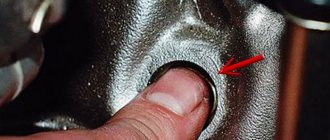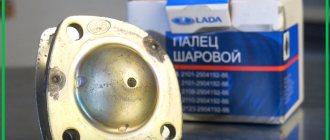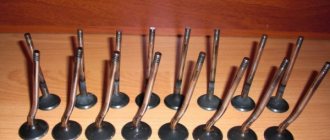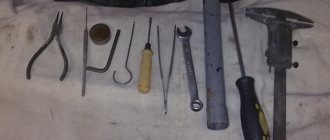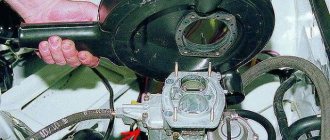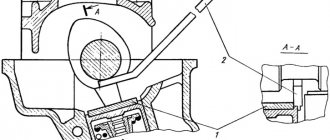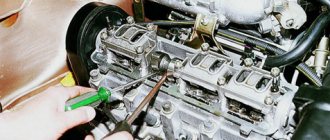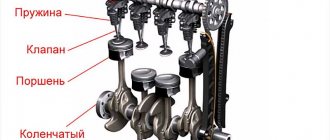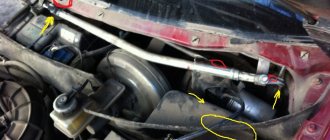Symptoms of out-of-adjustment valves
There are quite a lot of them. One of them is a loud metallic knocking sound in the engine. The sound becomes stronger as engine load increases and may be accompanied by a burning smell. If the valves in the cylinders are not adjusted, the compression drops noticeably - this can be determined using a compression meter. The engine “troits” - it vibrates at low speeds, it does not develop full power: there is sluggish acceleration and increased fuel consumption. All these signs indicate that the distribution mechanism is not working correctly: the valves need to be adjusted. What will it give? More on this below.
Is it possible not to adjust the valves?
Modern cars are equipped with so-called hydraulic compensators. Conventional engines have camshaft lobes, or “pushers,” that push the valve. As for hydraulic compensators, they themselves find the necessary clearance to release gases at high oil pressure. They ensure optimal valve operation in all cases. Many people ask the question: “If you don’t adjust the valves, what will happen?” If the car has hydraulic compensators, then valve adjustment is not necessary. Otherwise, the valves need to be adjusted and checked periodically.
Why is valve adjustment necessary?
Correctly adjusted clearances guarantee stable operation of the power unit at low and high speeds. At the same time, the best engine response and optimal fuel consumption are maintained. But the question arises: what is the valve clearance for? The fact is that they close thanks to a special spring resting against the cam. To prevent it from preventing the valve from closing completely, it is necessary to set a certain gap. And here you also need to take into account the heating of the valve stem (intake up to 300-400, exhaust up to 700-900 degrees), which causes an increase in its length. If the camshaft is located on top, then it directly or through a rocker arm acts on the rod, which causes increased wear. To prevent such a development of events, the end of the valve in some car models is covered with a “glass”: adjusting washers are placed between it and the camshaft cam. In other car models there are rocker arms: then adjustment between the metal parts is made using screws and locknuts.
Compensators
Most car engines are equipped with these devices today. Hydraulic compensators are installed on engines with more than two valves per cylinder.
These products themselves “select” the required valve clearance and guarantee the best timing operation under any conditions without adjustments. However, some car enthusiasts, not without reason, consider the traditional gas distribution mechanism with periodic checks of the gap to be more reliable. The thing is that compensators tend to break.
If the hydraulic compensators malfunction, they begin to knock. What causes knocking and how to deal with it can be read here.
How to adjust valves
All procedures must be carried out only on a cold engine. This is done to ensure that the setup results remain standard: this is exactly what they do at the manufacturing plants. It is worth noting that the procedure for adjusting the valves on each car is different: you can find it out from the instructions for the car or the relevant literature. The process is carried out by screwing in or unscrewing special adjusting screws, or by selecting flat washers. Each of these options is considered separately.
Using special tools
Engine valves are adjusted using a set of feeler gauges or a special rack and indicator. Both methods are quite widespread: the first is simple, accessible and requires minimal financial and time costs. To apply the second method, you will have to buy a device and a special device.
Adjustment using feeler gauge and locknuts
This method of setting the timing belt is typical for Russian rear-wheel drive cars (“classics”). Algorithm of actions:
- Remove the air filter housing and disconnect all tubes, cables and levers from the valve cover. To make it easier to turn the engine crankshaft, remove the spark plugs.
- Remove the valve cover and the front timing belt cover (if there is one, it may also be a chain).
- Set the piston of the cylinder from which the procedure will begin (for example, in the Zhiguli “classic” it is the 4th) to the top dead center position: the valves will be in the closed position.
- Observing the indentation mark on the engine shaft pulley, rotate it until it coincides with the mark on the lower front cover of the BC. The recessed point on the timing shaft sprocket should also coincide with the mark on its “bed” (housing).
- Use an open-end wrench to hold the adjusting hardware and at the same time loosen the locknut. Next, you need to use a set of feeler gauges to adjust the valves. Select the thin plate you need and insert it between the rocker arm and the valve stem. When adjusted normally, the feeler gauge will pass through with little friction. The gap value must be adjusted according to the table, which is different for each car (for VAZ2101-07 - 0.15 mm). Now tighten the locknut and check the clearance again. Repeat the operation if necessary. Follow the order of valve adjustment: for example, for a VAZ classic: 8-6, 4-7, 1-3, 5-2.
Adjustment using washers
This type of timing adjustment is more typical for front-wheel drive cars. To produce it, you need:
- Remove the valve cover.
- Find the marks on the engine block, timing belt pulley and, turning the crankshaft clockwise, make sure they match. As a result, the first piston will be in the TDC position.
- Determine the gap between the shim and the camshaft cam (they are the first when viewed from the pulley side).
- If there is a larger or smaller gap, select another washer (each has a corresponding marking; if not, use a caliper, or better yet, a micrometer).
- After installing the washer, check the gap again: the permissible deviation is no more than 0.05 mm in both directions.
- Do not forget that the gap size for the intake and exhaust valves is different - this parameter must be found out from the operating instructions for a particular car.
What is the effect of unadjusted valves?
Internal combustion engines that are installed in modern cars are quite complex mechanisms with many parts. Therefore, they require proper maintenance to function properly over a long period of time.
Unfortunately, many motorists do not pay due attention to this. For example, they do not very well understand why valve adjustment is needed and often ignore this procedure, which leads to additional breakdowns and high repair costs. In this material we will talk about what valve adjustment is, which engines need it and how it is performed.
- What is valve adjustment?
- Which engines need valve adjustment and when?
- Valve adjustment procedure
- on the topic
Valve Adjustment Tools
To carry out quality repair work, you must have the appropriate tools. To adjust the valve mechanisms, you will need the following tools:
- Set of keys (socket and open-end). 13mm and 17mm wrenches are required.
- Feeler gauge for determining the gap.
- Screwdrivers.
- Felt pen.
- Rags.
The gap gauge for classic VAZ cars should be 0.15 mm thick.
After how many kilometers should the fuel filter be changed?
How to adjust using the rack and indicator
To adjust the thermal clearance of the valves, a special rail paired with an indicator can be used. This set helps achieve greater accuracy than using a feeler gauge or washers.
Set with rail and indicator for adjusting valve thermal clearances
The work order is as follows:
- After the preparatory procedures and removal of the valve covers, the engine is cranked until the mark on the camshaft gear matches the body mark.
- Using a marker on the back side of the gear relative to the factory mark, you can put your marks every 90 degrees.
- Using three bolts, fix the rack on the protrusion of the bearing block.
- A dial indicator with a scale set to “0” is placed in a special slot on the bar.
- A special device is used to take the cam and pull it upward, after which the indicator needle moves by 50–52 divisions. If the numbers obtained are different, then the valve is adjusted according to the scenario described when working with the dipstick.
Signs and consequences of improper clearance
After starting the engine, it itself and all its parts begin to heat up significantly and automatically expand. It is also worth taking into account the natural wear and tear of the elements in contact with each other. All this is the basis for ensuring strictly established gaps between certain parts. Deviations from the norm can lead to certain problems. The list of them depends on which direction the gaps have changed - more or less.
Gap too big
If the gap is larger than the required size, the driver will begin to hear the characteristic clatter of the engine, which gradually goes away as the car warms up. With increased clearance, the camshaft fist does not push through the rocker of the valve stem, but simply begins to knock on it.
Such long-term shock load leads to such unpleasant consequences as:
- significant reduction in valve life;
- riveting;
- chipping of the end, which further increases the gap;
- increased noise during engine operation.
At the same time, engine power decreases due to serious disruption of gas distribution processes.
Gap too small
With a very small gap, the car engine will not be able to fully realize its functionality. This will automatically affect the overall speed and dynamic characteristics of the vehicle. At the same time, there will be significant overheating of all exhaust valves with melting of their edges. Among the main consequences of a reduced gap size are the following factors, based on the loss of combustion chamber tightness:
- Reducing compression due to the release of the air-fuel mixture.
- During the working stroke, exhaust and hot gases break through and lead to severe burnout of the valves.
- The plates no longer touch the seats, which disrupts heat transfer.
- The valves are heated to temperatures that significantly increase corrosion and oxidation.
- Increased load on timing belts.
Based on everything said above, we can conclude that adjusting the gaps must be done without fail. The process must be carried out if the following signs are present:
- in the upper part of the cylinder head of installed cylinders there is an extraneous, slightly ringing noise;
- repair of the gas distribution mechanism;
- the adjustment was made more than 20 thousand kilometers ago;
- a clear decrease in engine output;
- increased fuel consumption.
The engines of modern cars are designed in such a way that thermal clearances must be adjusted manually. For some it may seem simple, while others consider this process serious and responsible. It all depends on the driver’s experience, the availability of certain skills and tools. Moreover, there is no difference between diesel and gasoline engines. The adjustment process is carried out here according to the same scheme.
It is advisable to combine the adjustment with an oil change. This will prevent dirt, sand and dust from getting into the engine.
Adjustment sequence
So, we aligned the mark on the camshaft with the bevel on its cover and checked that they matched the knees. shaft Additionally, you can check the correct installation using the distributor slider. Its contact protrusion should be directed towards the output of the high voltage wire of the 4th cylinder.
If all marks match, you can begin checking and adjusting.
The procedure for adjusting the VAZ-2103 valves is given in the table:
| The procedure for adjusting the valve mechanism of the VAZ “Classic” | |
| Knee rotation angle. shaft | Adjustable valves |
| 8, 6 | |
| 180 | 4, 7 |
| 360 | 1, 3 |
| 540 | 5, 2 |
Procedure for adjusting valve thermal clearances
Almost all internal combustion engines of modern cars have a right-hand rotation of the crankshaft - the crankshaft rotates clockwise. The camshaft is driven from the c/shaft, and rotation is transmitted to the camshaft through a belt or chain. There can be several camshafts in an engine; how many there are in an engine depends on the design features of the power unit.
Each camshaft (CV) must have cams, which ensure the opening and closing of the valves and the filling of the internal combustion engine cylinders with the air-fuel mixture. In order for compression to be created in the cylinders, the valves in the cylinder head must be tightly sealed against their seats at the moment of closing.
Consequences of incorrect valve adjustment
If the described timing elements are adjusted incorrectly, the engine’s operating efficiency will noticeably decrease. If the clearance is insufficient, the valves themselves and their seats will experience increased loads, which can lead to burnout. With an increased gap, an unpleasant metallic knock will be heard in the cabin, and the power of the power unit will drop.
In any case, the result of incorrect or untimely valve adjustment will be the failure of timing parts, which leads to significant financial expenses.
Consequences of untimely adjustment
It is known that untimely carrying out any operation to repair and maintain a car entails certain consequences, which can be, in one case, mild, and in another, fatal for the power unit. So, let's look at the main ones:
- Worn parts and assemblies of the cylinder head, namely the gas distribution mechanism.
- Wear of camshafts.
- Partial or complete destruction of pushers.
- In a separate case, it leads to a broken timing belt and corresponding consequences, such as. !
How to adjust the valves if there is a gas system
When the engine runs on liquid fuel, the temperature of the valves reaches 350, and the “plates” - 900 degrees. When using gas as fuel, this parameter increases by 50-70 degrees. Such an increase in itself is not dangerous: the valve will not burn out or collapse.
A much greater risk is posed by incorrect adjustment of the power system when a lean mixture is formed. In this case, the temperature on the surface of the valves increases by 200-250 degrees, which leads to burnout of the valves. Conclusion: using gas for timing is not dangerous, but you need to watch the quality of the mixture.
How often are adjustments made?
If we talk about mileage, then it is 20-30 thousand km. Adjustment of the thermal clearances of the valves should be carried out even if you do not experience a loss of power, increased fuel consumption and black smoke from the muffler (you should not wait for the first symptoms to appear). It is best to carry out the procedure in a car service center, but if you have the appropriate tools, equipment and experience, this can also be done in your garage.
The design of a four-stroke internal combustion engine is, in principle, quite simple and understandable. The air-fuel mixture from the intake manifold enters the combustion chamber through the intake valves. Then, the valves close and the process of compressing the mixture begins, which occurs due to the upward movement of the piston.
Further, at a certain moment, approximately near the top dead center of the cylinder, the mixture is ignited, which is carried out by the spark plug. Obeying the laws of physics, the mixture expands under the influence of temperature and pushes the piston back down, converting thermal energy into mechanical energy. The last stroke of the piston is the release of exhaust gases into the exhaust system through the opened exhaust valves.
As you can see, everything is simple.
In this description, there was twice a mention of valves, inlet and outlet, which require periodic adjustment of the so-called thermal clearances. Let's see together what it is and why it is needed.
So, the thermal gap is a special gap left between the camshaft cam (or rocker arm) and the valve stem. Its necessity is very simple - when the engine heats up, the metal, obeying the same physics, begins to expand, and the valve (more precisely, its stem) lengthens. The gap is designed to level out this expansion.
Everything seems to be simple and clear again. However, over time, approximately every 40,000 km, the valve clearances “go away” and become (as a rule) larger than required. In this case, they need to be adjusted and returned to the original value, because the resulting excessive gap will lead to wear on the rocker arm or camshaft cam, since an impact load will appear on them.
